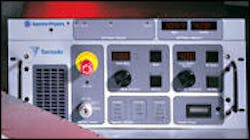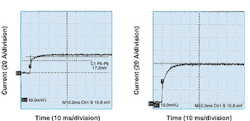Power supplies adapted for diode-pumped laser systems
by Don Novotny, Doug Breckinridge, and Kevin Hartke
Programmable direct current power supplies overcome current overshoot difficulties associated with supplying power to industrial laser systems.
While designing a power supply for its industrial diode-pumped laser systems, semiconductor-based laser and optical technologies manufacturer Spectra-Physics (Mountain View, CA) encountered current overshoot that can cause significant damage to laser-diode stacks. Working with engineers at Sorensen, a division of Elgar Corp. (San Diego, CA), a programmable direct current (dc) power supply was designed to handle the current requirements for the laser-diode stacks.
Power supply criteria
Typical laser diodes measure less than 1 mm in diameter and weigh a fraction of a gram. These devices are coupled together to provide higher power and brightness diode arrays and stacks, which are then used to pump a solid-state media that makes a diode-pumped solid-state laser (DPSSL). Most laser diodes require only a few milliwatts of power at 3 to 12 V direct current and several milliamps. They are very sensitive to overcurrent, which was the problem encountered by Spectra-Physics when powering its laser diodes. So, Spectra-Physics had certain criteria in mind when selecting power supplies for a stack-pumped, 50-W multimode solid-state laser designed for marking, plastics welding, soldering, and other materials processing applications (see Fig. 1).
The first requirement was that the power supply had to work for a specific applicationproviding power to laser diodes. For some diodes, it is desirable to have adjustable current levels because currents vary depending on the application of the laser diode. A power supply with variable voltage and current (90% of power supplies have fixed output current and voltage) can be programmed over a wide range to the spectrum of desired voltages and currents. An Institute of Electrical and Electronics Engineers' (IEEE) bus or an analog input connects the power supply to the diode stack. By changing the amount of current produced from the supply, the output of the laser can be varied in a short period of time. This adjustable current option is necessary for many applications that require power adjustment on the fly.
When current is used to pump DPSSLs, current noise becomes critical. Modulation on the current translates directly to modulation on the pump level, which consequently affects laser power, pulse energy, and spatial mode. The supply also must be "well-behaved" during various fault conditions. Laser diodes can be quite sensitive, and a few miliseconds of overcurrent can cause catastrophic optical damage.
Heterojunction diodes can be damaged by even small voltage reversals, so the power supply for these diodes must be adjustable and programmable to tolerate a range of forward voltage drops. If the power supply were to reverse voltage or throw a current spike when the alternating current (ac) input line is abruptly removed or the load is abruptly disconnected, it could result in catastrophic optical damage. A safeguard for this problem is to have over-voltage protection (OVP). An OVP circuit detects when the diode becomes disconnected and provides a flag to the user that the circuit has opened, as well as preventing the possibility of excessive current discharge if the diode load is reconnected while the power supply is on.
Low ripple and noise are also desirable. Laser diodes respond to energy input, so noise from the supply interferes with testing and results in distorted output from the diode.
Overcurrent problems and issues
Spectra-Physics' problem with the power supply was determined to occur when the power was turned on and off during various laser-diode testsresulting in damaged laser-diode stacks. The problem had to do with the way that general-purpose programmable dc power supplies typically operate. Most of the equipment powered by these power supplies requires voltage-mode regulation. A set voltage is programmed into the supply and when the equipment being powered reaches that specific voltage, the equipment starts. Current is not a factor, because the current does not start flowing until the equipment is operating.
Most applications require a fast current sourcing capability. To achieve this, a current overshoot is built in. When the power is first turned on, the voltage is set higher than needed, and the current is set at the level needed for conduction. Voltage is ramped up, the current overshoots the preset level, the equipment turns on, and the current quickly drops to the preset level for proper operation. The transition from voltage mode to current mode can cause a current overshoot. In 90% of applications, this transition goes smoothly (see Fig. 2).
There are only a few "current-mode" controlled equipment applications (where the current is regulated instead of the voltage). In applications where heat is dependent on current running through a wire, like magnets and heater coils, current is a factor, but current overshoot is not an issue because these loads look like resistors to the power supply.
Providing power to laser diodes is an application that is adversely affected by current overshoot because the power supply is turned on and off throughout each change of shift or work cycle. Each time power is turned on, a current overshoot occurs and the higher-power pulse entering the laser diode causes it to fail.
Overcurrent solution
Laser diodes are very sensitive to current spikes and need a steady application of electricity. The solution was to adjust the initial current ramp-up time to be slow enough so that the overcurrent would not occur. By not allowing the current to ramp up as rapidly, the laser diode begins operation before an overshoot condition can occur. To adapt the power supply, the reference control to the current differential amplifier was slowed during the initial turn-on or reset of the supply. This was accomplished by adding a resistor-capacitor (RC) circuit to slow the current control during the initial ramp up. The time to go to the programmed value from microseconds to milliseconds was increased, but is transparent to the laser system operation. After the initial reference is ramped up, the current transient response is unaffected because this change is outside the feedback loop.
DON NOVOTNY is the marketing manager at Sorensen, 9250 Brown Deer Road, San Diego, CA 92121; e-mail: [email protected]. DOUG BRECKINRIDGE is an electrical engineer and KEVIN HARTKE is the product manager at Spectra-Physics Inc., 1335 Terra Bella Ave., Mountain View, CA 94043; e-mail: [email protected].


